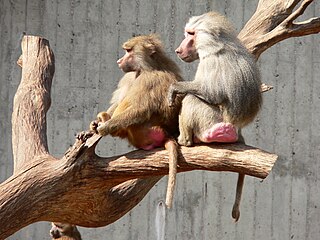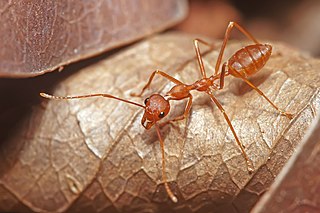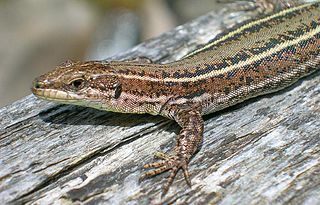Related Research Articles

Aggression is hostile and antagonistic behavior, often with the intent to cause harm, although it can be channeled into creative and practical outlets for some. It may occur either reactively or without provocation. In humans, aggression can be caused by various triggers. For example, built-up frustration due to blocked goals or perceived disrespect. Human aggression can be classified into direct and indirect aggression; whilst the former is characterized by physical or verbal behavior intended to cause harm to someone, the latter is characterized by behavior intended to harm the social relations of an individual or group.

In ethology, territory is the sociographical area that an animal consistently defends against conspecific competition using agonistic behaviors or real physical aggression. Animals that actively defend territories in this way are referred to as being territorial or displaying territorialism.

The olive baboon, also called the Anubis baboon, is a member of the family Cercopithecidae Old World monkeys. The species is the most wide-ranging of all baboons, being native to 25 countries throughout Africa, extending from Mali eastward to Ethiopia and Tanzania. Isolated populations are also present in some mountainous regions of the Sahara. It inhabits savannahs, steppes, and forests. The common name is derived from its coat colour, which is a shade of green-grey at a distance. A variety of communications, vocal and non-vocal, facilitate a complex social structure.

The hamadryas baboon is a species of baboon within the Old World monkey family. It is the northernmost of all the baboons, being native to the Horn of Africa and the southwestern region of the Arabian Peninsula. These regions provide habitats with the advantage for this species of fewer natural predators than central or southern Africa where other baboons reside. The hamadryas baboon was a sacred animal to the ancient Egyptians and appears in various roles in ancient Egyptian religion, hence its alternative name of 'sacred baboon'.

Dog aggression expressed by dogs is considered to be normal behaviour and various types of aggression are influenced by a dog's environment and genetic predisposition. Dogs commonly display possessive aggression when defending resources or themselves.

The New Zealand bellbird, also known by its Māori names korimako, makomako, and kōmako, is a passerine bird endemic to New Zealand. It has greenish colouration and is the only living member of the genus Anthornis. The bellbird forms a significant component of the famed New Zealand dawn chorus of bird song that was much noted by early European settlers. The explorer Captain Cook wrote of its song "it seemed to be like small bells most exquisitely tuned". The species is common across much of New Zealand and its offshore islands as well as the Auckland Islands.

Weaver ants or green ants are eusocial insects of the family Formicidae. Weaver ants live in trees and are known for their unique nest building behaviour where workers construct nests by weaving together leaves using larval silk. Colonies can be extremely large consisting of more than a hundred nests spanning numerous trees and containing more than half a million workers. Like many other ant species, weaver ants prey on small insects and supplement their diet with carbohydrate-rich honeydew excreted by small insects (Hemiptera). Weaver ant workers exhibit a clear bimodal size distribution, with almost no overlap between the size of the minor and major workers. The major workers are approximately 8–10 mm (0.31–0.39 in) in length and the minors approximately half the length of the majors. Major workers forage, defend, maintain, and expand the colony whereas minor workers tend to stay within the nests where they care for the brood and 'milk' scale insects in or close to the nests.
Sex differences in crime are differences between men and women as the perpetrators or victims of crime. Such studies may belong to fields such as criminology, sociobiology, or feminist studies. Despite the difficulty of interpreting them, crime statistics may provide a way to investigate such a relationship from a gender differences perspective. An observable difference in crime rates between men and women might be due to social and cultural factors, crimes going unreported, or to biological factors for example, testosterone or sociobiological theories). The nature of the crime itself may also require consideration as a factor.

Podarcis hispanicus, also known as Iberian wall lizard, is a small wall lizard species of the genus Podarcis. It is found in the Iberian peninsula, in northwestern Africa and in coastal districts in Languedoc-Roussillon in France. In Spanish, this lizard is commonly called lagartija Ibérica.

Cosmophasis is a genus of spiders in the family Salticidae. They are predominantly Southeast Asian, while some species occur in Africa and Australia. Although most species more or less mimic ants, there are also colorful species that follow a different strategy.

Rhabdomys is a largely Southern African genus of muroid rodents slightly larger than house mice. They are known variously as striped or four-striped mice or rats. Traditionally the genus has been seen as a single species, Rhabdomys pumilio, though modern evidence on the basis of karyotype and mtDNA analysis suggests that it comprises two or more species and subspecies. Dorsally Rhabdomys species display four characteristic black longitudinal stripes on a paler background.

Agonistic behaviour is any social behaviour related to fighting. The term has broader meaning than aggressive behaviour because it includes threats, displays, retreats, placation, and conciliation. The term "agonistic behaviour" was first defined and used by J.P Scott and Emil Fredericson in 1951 in their paper "The Causes of Fighting in Mice and Rats" in Physiological Zoology.Agonistic behaviour is seen in many animal species because resources including food, shelter, and mates are often limited.

Anomaloglossus beebei is a species of frog in the family Aromobatidae. This frog is endemic to Guyana, specifically in the Kaieteur National Park. It mainly survives on the giant bromeliad called Brocchinia micrantha. The phytotelmata of this bromeliad is the site of oviposition and tadpole rearing and are defended over time by the males. The females of this species are more brightly golden colored whereas males are more of a dull tan with brown pigmentation. Males take care of offspring and are preferred due to the elongation of their calls.

Neolamprologus pulcher is a species of cichlid endemic to Lake Tanganyika where it prefers locations with plenty of sedimentation. The common names for N. pulcher include daffodil cichlid, fairy cichlid, princess of Zambia and lyretail cichlid. This species can reach a length of 10 centimetres (3.9 in) TL. It can also be found in the aquarium trade.

Baboons are primates comprising the genus Papio, one of the 23 genera of Old World monkeys, in the family Cercopithecidae. There are six species of baboon: the hamadryas baboon, the Guinea baboon, the olive baboon, the yellow baboon, the Kinda baboon and the chacma baboon. Each species is native to one of six areas of Africa and the hamadryas baboon is also native to part of the Arabian Peninsula. Baboons are among the largest non-hominoid primates and have existed for at least two million years.

Infanticide is the termination of a neonate after it has been born, and in zoology this is often the termination or consumption of newborn animals by either a parent or an unrelated adult. In rodents, it is not uncommon for the mother to commit infanticide shortly after parturition under conditions of extreme stress, or for an unrelated male to kill neonates.
The dear enemy effect or dear enemy recognition is an ethological phenomenon in which two neighbouring territorial animals become less aggressive toward one another once territorial borders are well established. As territory owners become accustomed to their neighbours, they expend less time and energy on defensive behaviors directed toward one another. However, aggression toward unfamiliar neighbours remains the same. Some authors have suggested the dear enemy effect is territory residents displaying lower levels of aggression toward familiar neighbours compared to unfamiliar individuals who are non-territorial "floaters".

Anomaloglossus kaiei is a species of frogs in the family Aromobatidae, commonly known as the Kaie rock frog. It was named in honor of Kaie, a great Chieftain of the Patamona tribe, who sacrificed himself to the Great Spirit Makonaima by canoeing over the Kaieteur falls in order to save his own people. It is endemic to Guyana where it is known from the Kaieteur National Park and the Pacaraima Mountains. However, as it is found along the Guyana–Brazil border, it is also possibly present in Brazil. This frog shows maternal care: female frogs can provide tadpoles with trophic eggs.
Aggression refers to negative behavior or attitudes toward another, mainly by applying physical force. Evolution on the other hand, is any process of formation or development of something like habit, trait or character in a population from generation to generation. Evolution can explain why fish exhibit aggression because it is a simple emotion. This emotion increases an individual's survival or reproduction. Aggressive behavior can derive in fish species due to territory, sex specific selection and genetic variation. There is no specific fish species who display invasive behavior. Almost all the fish are aggressive sometimes in their lives depending on their surroundings.

Dianne Heather Brunton is a New Zealand ecologist, and head of the Institute of Natural and Computational Sciences at Massey University. Her research area is the behaviour and cultural evolution of animal communication, especially bird song in southern hemisphere species such as the New Zealand bellbird.
References
- ↑ Schradin C, Schneider C, Lindholm AK (2010). "The nasty neighbour in the striped mouse (Rhabdomys pumilio) steals paternity and elicits aggression". Frontiers in Zoology. 7 (19): 19. doi: 10.1186/1742-9994-7-19 . PMC 2908079 . PMID 20573184.
- ↑ Newey, P.S., Robson, S.K., Crozier, R.H., (2010). Weaver ants Oecophylla smaragdina encounter nasty neighbors rather than dear enemies. Ecology, 91(8):2366-72
- ↑ Müller, C.A., Manser, M.B., (2007). 'Nasty neighbours' rather than 'dear enemies' in a social carnivore. Proc. R. Soc. B., 274: 959-965
- ↑ Brunton DH, Evans B, Cope T, Ji W (7 March 2008). "A test of the dear enemy hypothesis in female New Zealand bellbirds (Anthornis melanura): female neighbors as threats". Behavioral Ecology. 19 (4): 791–798. doi: 10.1093/beheco/arn027 . Archived from the original on 2013-06-17.
- ↑ Temeles EJ (January 1990). "Northern harriers on feeding territories respond more aggressively to neighbours than to floaters". Behav. Ecol. Sociobiol. 26 (26): 57–63. doi:10.1007/BF00174025.
- ↑ Maciej P, Patzelt A, Ndao I, Hammerschmidt K, Julia Fischer J (January 2013). "Social monitoring in a multilevel society: a playback study with male Guinea baboons". Behav. Ecol. Sociobiol. 67 (1): 61–68. doi:10.1007/s00265-012-1425-1. PMC 3536999 . PMID 23293423.